Femia > Health Library > Getting Pregnant > Challenges > OHSS symptoms: Recognizing and managing ovarian hyperstimulation syndrome
OHSS symptoms: Recognizing and managing ovarian hyperstimulation syndrome
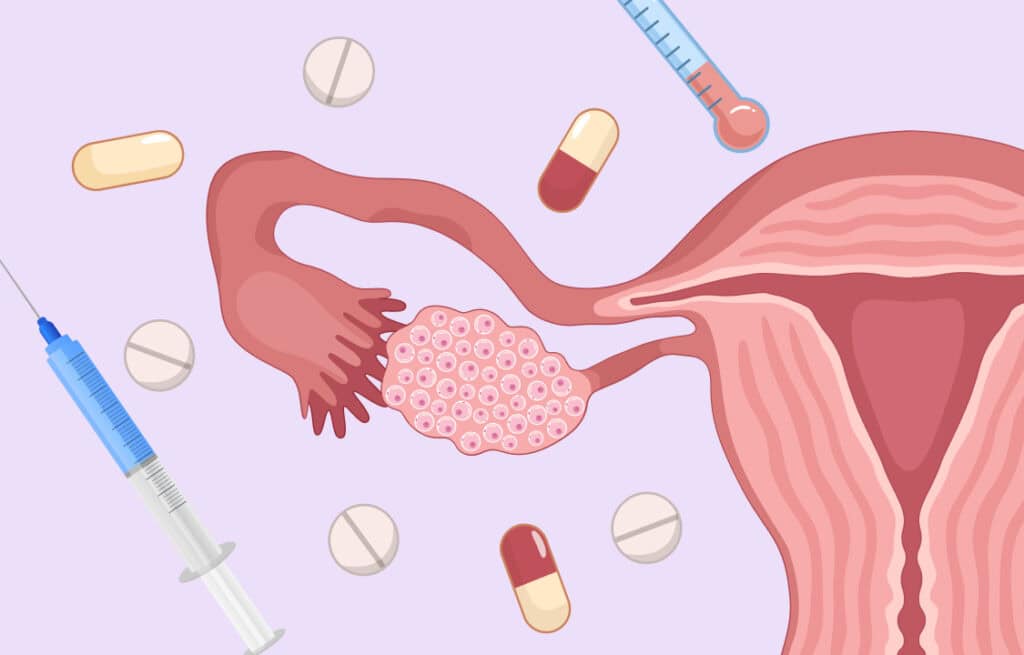
- Updated Feb 11, 2025
- Published
CRAFTED BY HUMAN
Crafted by human At Femia, we provide accurate and up-to-date information at every stage of your journey, from trying to conceive, pregnancy and postnatal support. All content is created by a real person based on in-depth research and own professional experience. Femia ensures that you will receive expert advice, strict accuracy and a personalized approach from our authors/medical experts. Learn more about our editorial policy.
FACT CHECKED
Fact checked At Femia Health, we maintain the highest standards of editorial excellence in delivering content focused on helping you conceive, guiding you through pregnancy, and supporting you postpartum. Explore our content review principles to learn how we ensure the accuracy and quality of our health and lifestyle tips for every stage of your journey.
- Ovarian hyperstimulation syndrome (OHSS) is a potential complication of fertility treatments, especially during in vitro fertilization (IVF). An exaggerated ovarian response to hormonal medications causes it.
- Symptoms range from mild to severe, including significant weight gain, reduced urination, and blood clots.
- While mild cases often resolve with home care, like drinking enough water and avoiding high-sodium foods, severe cases require immediate medical attention. There are some preventative measures like medication adjustments, using a “freeze-all” cycle, switching to alternative ovulation triggers, and regular monitoring during IVF.
Ovarian hyperstimulation syndrome (OHSS) is a potential complication of fertility treatments. It is an exaggerated response to excess hormones. This syndrome causes the ovaries to swell and become painful.
OHSS syndrome might be a serious condition, but early recognition and treatment can prevent complications. The chosen treatment will depend on the severity of the condition, as in mild cases, OHSS may improve on its own, while severe cases require additional treatment. Let’s learn about OHSS in detail – when it occurs, its symptoms, and management tips.
Femia offers a plan to help you remove your blocks to get pregnant
What is ovarian hyperstimulation syndrome (OHSS)?
Ovarian hyperstimulation syndrome (OHSS) is a condition where the enlarged ovaries causing an immune response that results in fluid leaking from blood vessels. This causes abdominal fluid or ascites, bloating, dehydration, reduced urination, etc.. OHSS is a complication that may occur in women who undergo fertility treatments as they stimulate ovaries to produce a large number of eggs.
Women normally release one egg per menstrual cycle. However, women with fertility problems who can’t conceive may opt for hormonal treatments to help them produce multiple eggs, particularly when they plan egg retrieval for in vitro fertilization (IVF).
And sometimes, ovaries may over-respond to these medications, causing OHSS. This syndrome is more common in the case of injectable drugs rather than oral.OHSS is also more common in women with polycystic ovary syndrome (PCOS) – a reproductive disease that involves a hormonal imbalance.
👉Find out more: How to improve egg quality: Tips for boosting fertility at any age
When does OHSS occur?
The signs and symptoms of OHSS vary depending on treatment, pre-existing conditions like PCOS, and the severity of the condition. Most women notice symptoms within a week after using medication for ovulation stimulation. However, in some cases, symptoms can take two weeks to develop.
OHSS most often develops because of the hCG (human chorionic gonadotropin) stimulating your ovaries. Women undergoing fertility treatments receive a “trigger shot” of hCG hormone that helps the eggs mature faster before egg retrieval.
OHSS symptoms: How to recognize them
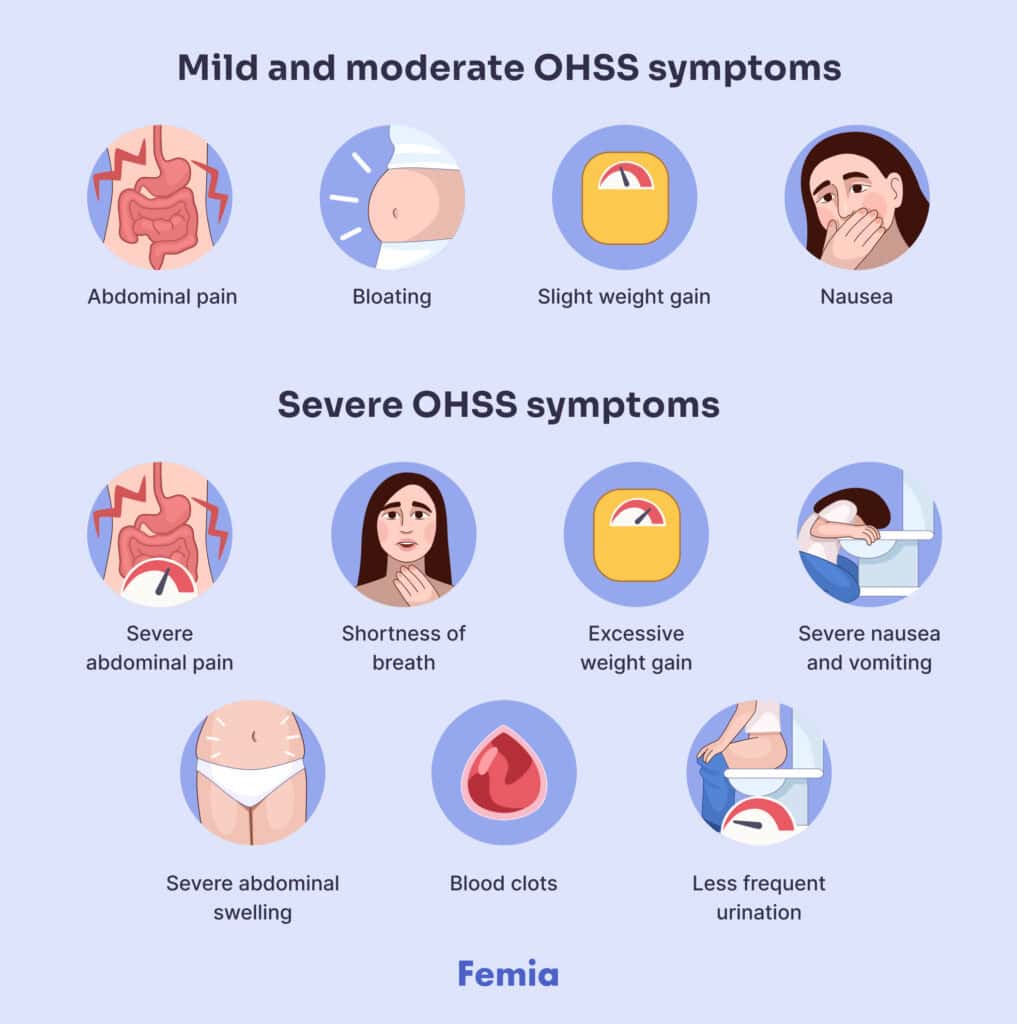
It’s essential to contact your healthcare provider if you notice any of the changes or symptoms listed below after receiving fertility medication. Your doctor will monitor you and will tell you if you have a risk of developing OHSS based on your estrogen levels and the number of follicles on the ultrasound.
Mild ovarian hyperstimulation syndrome (OHSS) symptoms often appear shortly after egg retrieval or during the luteal phase of the IVF treatment. Symptoms are generally manageable at home. Enlarged ovaries are detected via an ultrasound, but they usually cause no significant complications at this stage.
Mild and moderate OHSS symptoms IVF include:
- Abdominal pain
- Bloating
- Slight weight gain (more than 2 pounds per day)
- Nausea
Severe OHSS is a serious condition requiring immediate medical attention. Symptoms may include:
- Severe abdominal pain
- Shortness of breath
- Excessive weight gain
- Severe nausea and vomiting
- Severe abdominal swelling
- Blood clots
- Less frequent urination
Other concerning signs are dark or reduced urine output and severe dehydration, all leading to other complications if not treated promptly. Such a condition requires immediate medical intervention, which is critical to managing these severe symptoms effectively.
OHSS symptoms during IVF: What to expect
Mild symptoms of OHSS are common after egg retrieval, primarily due to the ovaries’ response to stimulation. These symptoms, such as bloating and mild discomfort, usually improve within a week without medical intervention.
However, if symptoms worsen, such as significant weight gain, increased abdominal swelling, or difficulty breathing, it’s essential to seek medical care promptly. Severe OHSS is rare but can be life-threatening if left untreated, making early detection and intervention crucial during IVF treatment.
👉Find out more: Why am I not getting pregnant? Understanding common reasons for conception challenges
Risk factors for OHSS
Women having the following health issues have a higher risk for OHSS:
- Have polycystic ovary syndrome (PCOS).
- Have previously had OHSS.
- Have many follicles or high levels of estrogen during IVF stimulation.
- Receive high doses of hCG during an IVF.
- Undergo a “fresh” transfer instead of “frozen” embryo transfer.
Although there is no clear evidence, there might also be a higher risk for OHSS in women who:
- Are younger than 30 years old.
- Weigh less than average.
How to prevent OHSS after egg retrieval
OHSS can occur after egg retrieval, mostly in patients undergoing ovarian stimulation for in vitro fertilization (IVF). Some strategies help minimize the risk of developing severe symptoms of ovarian hyperstimulation syndrome:
1. Use a "Freeze-all" cycle
Some healthcare providers may recommend delaying egg transfer by freezing all embryos since it allows the body to recover from ovarian stimulation before pregnancy begins. This approach helps reduce the risk of worsening OHSS, which can be exacerbated by the hormonal changes associated with early pregnancy.
2. Adjust medication dosages
If any symptoms occur, your doctor may suggest reducing the dosage of gonadotropins during ovarian stimulation to lower the risk of OHSS. Using fewer medications minimizes the overstimulation of the ovaries.
3. Switch to alternative triggers
Instead of human chorionic gonadotropin (hCG), which is more likely to provoke OHSS, a GnRH agonist can be used to trigger ovulation. This method is particularly effective for patients at high risk.
4. Close monitoring
Regular ultrasounds and blood tests throughout the stimulation cycle are crucial for identifying signs of excessive ovarian response. Adjustments to the treatment plan can be made promptly if necessary.
5. Hydration and diet
Staying hydrated is essential to maintain fluid balance. Avoid high-sodium foods, which can worsen bloating and fluid retention, common symptoms of OHSS. You can also consider consuming foods that fight nausea to ease mild symptoms.
Femia offers a plan to help you remove your blocks to get pregnant
How to manage OHSS symptoms at home
It’s important to note only mild OHSS symptoms after egg retrieval might be managed at home. However, it is essential to consult a healthcare provider, even if there are minor symptoms, for more customized guidance.
For mild OHSS, symptoms may be managed at home with the following self-care measures:
- Get enough rest. Try to avoid strenuous activities and exercise, which can worsen discomfort and increase the risk of ovarian torsion. Consider instead light activities like walking as they are generally acceptable.
- Stay hydrated. Drink enough water (2.7 liters) and electrolyte-rich drinks like oral rehydration solutions. This helps to maintain a healthy hydration level and support kidney function. It is also important to avoid alcohol and caffeine.
- Pain relief. If experiencing any pain or abdominal discomfort, consider using heating pads to ease bloating. You can also use over-the-counter pain relievers, like acetaminophen, but make sure you approve drug choices with your healthcare provider.
- Monitor symptoms. Mild OHSS symptoms may turn severe if not carefully monitored. So if diagnosed, ensure you closely monitor how you feel and contact your healthcare provider immediately if you experience escalating symptoms such as severe abdominal pain, significant weight gain (more than 2 pounds per day), difficulty breathing, or reduced urination.
When to seek medical attention
It is important to contact your fertility clinic or emergency services if you experience severe symptoms, including:
- Difficulty breathing because of a build-up of fluid in your lungs
- Reduced urination and dark urine
- Blood clots in your legs or lungs. These come with swollen, tender legs or pain in the chest
- Rapid weight gain
- Signs of dehydration
Questions from the Femia community
Can OHSS occur naturally without fertility treatments?
OHSS is uncommon among those not undergoing fertility treatments. However, it can still occur in rare cases because of naturally high estrogen hormone levels.
Does OHSS affect future fertility?
Mild cases of OHSS usually do not affect future fertility, but severe cases and potential complications, including infertility, should always be discussed with a specialist.
Can you get OHSS after a frozen embryo transfer?
OHSS is less likely after frozen embryo transfers because ovarian stimulation occurs before the transfer.
Are there any long-term complications from OHSS?
Mild cases can be resolved without long-term effects, but severe untreated OHSS often leads to complications like kidney damage and blood clots in rare cases. That's why it is essential to seek medical help promptly if any of the symptoms occur.
Can diet help prevent OHSS?
Staying hydrated and avoiding overly salty or sugary foods can help manage symptoms but there is no proven way to avoid OHSS entirely.
The bottom line
OHSS is a side effect of fertility treatments that can vary in severity – from mild symptoms resolving without intervention to severe cases requiring urgent medical care. Preventing this syndrome is a priority during IVF and can be achieved through careful monitoring, tailored medication doses, and alternative ovulation triggers.
While mild symptoms can often be managed at home with rest, hydration, and close monitoring, it’s critical to contact a healthcare provider if symptoms escalate, such as severe pain, rapid weight gain, or reduced urination. Early OHSS prevention with appropriate treatment can help reduce the risk of complications, ensuring a safer and more effective fertility journey. Emphasize open communication with your fertility specialist to navigate potential risks.
References
- Mayo Clinic. “Ovarian Hyperstimulation Syndrome – Symptoms and Causes.” Mayo Clinic, 9 Nov. 2021, www.mayoclinic.org/diseases-conditions/ovarian-hyperstimulation-syndrome-ohss/symptoms-causes/syc-20354697.
- Cleveland Clinic. “Menstrual Cycle (Normal Menstruation): Overview & Phases.” Cleveland Clinic, 2022, my.clevelandclinic.org/health/articles/10132-menstrual-cycle.
- Cleveland Clinic. “IVF (in Vitro Fertilization): Procedure & How It Works.” Cleveland Clinic, 2 Mar. 2022, my.clevelandclinic.org/health/treatments/22457-ivf.
- Cleveland Clinic. “Polycystic Ovary Syndrome (PCOS) & Treatment.” Cleveland Clinic, 15 Feb. 2023, my.clevelandclinic.org/health/diseases/8316-polycystic-ovary-syndrome-pcos.
- Cleveland clinic. “Human Chorionic Gonadotropin: Hormone, Purpose & Levels.” Cleveland Clinic, 11 Mar. 2022, my.clevelandclinic.org/health/articles/22489-human-chorionic-gonadotropin.
- Cleveland Clinic. “Blood Clots: Risks, Symptoms, Treatments, Prevention.” Cleveland Clinic, 24 Sept. 2020, my.clevelandclinic.org/health/diseases/17675-blood-clots.
- Cleveland Clinic. “Estrogen: Hormone, Function, Levels & Imbalances.” Cleveland Clinic, Cleveland Clinic, 2 Aug. 2022, my.clevelandclinic.org/health/body/22353-estrogen.
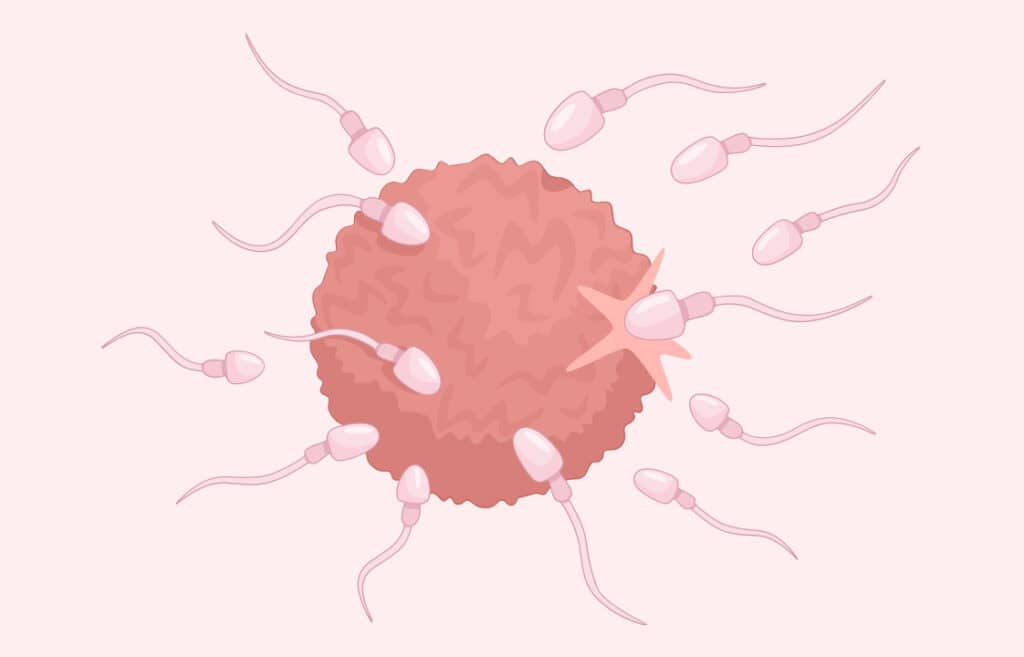
Learn how to get pregnant with poor sperm morphology. Discover lifestyle changes, medical treatments, and assisted reproductive technologies to improve your chances of conception.
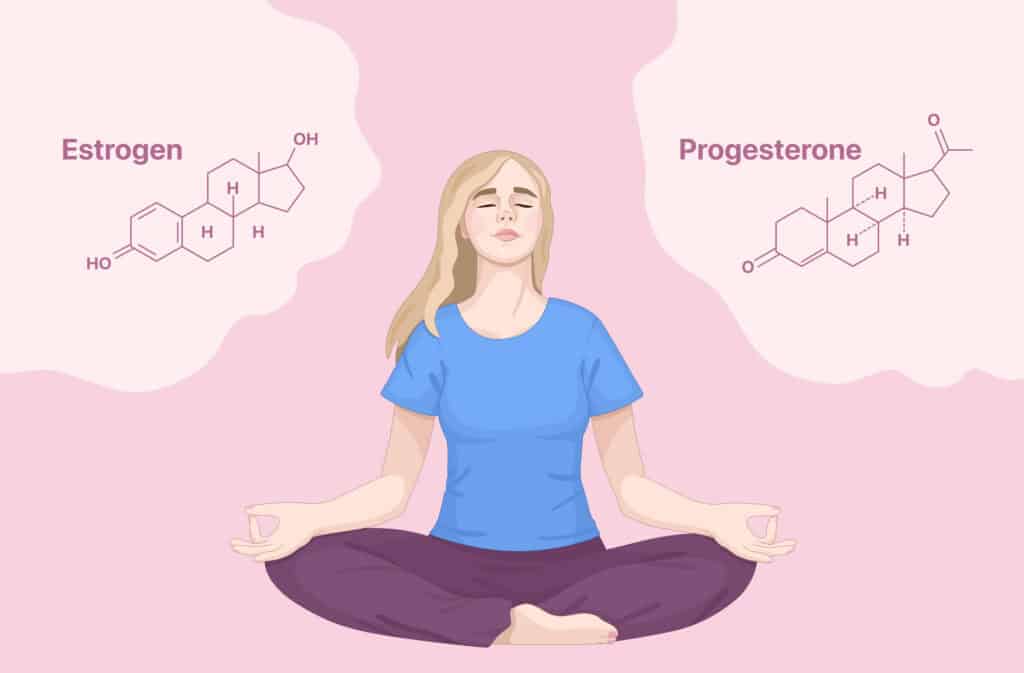
Let’s learn how two key female hormones – progesterone and estrogen – differ, how they affect different functions, and why they matter.
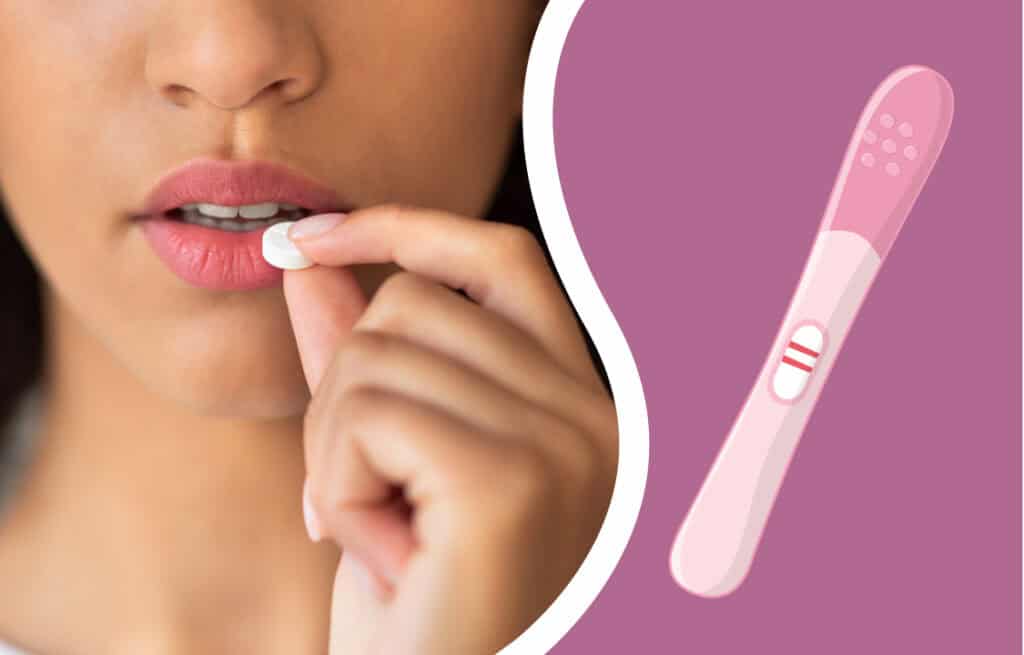
How to know if plan B worked? This can be a nerve-wracking question. If looking for answers, here are the common signs that plan b didn’t work.

